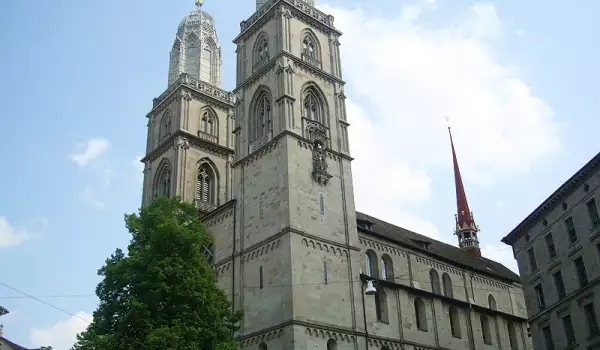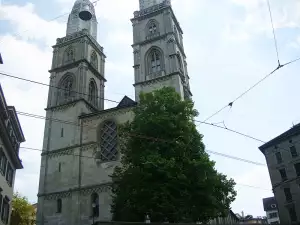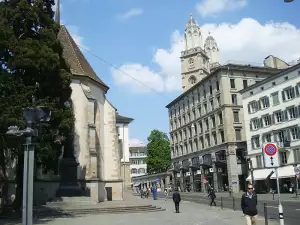Grossmünster

Grossmünster in Zurich is the largest cathedral in the most populous Swiss city. This is the evangelical Protestant church, situated in the old part of town. Grossmünster is one of the three main cathedrals in Zurich together with Fraumünster and St. Peterskirche. Even today, Grossmünster is considered a symbol of the protestant reformation. Located near the Limmat river in Old Town Zurich, it stands with two bell towers of its front facade
The present cathedral stands on the site of an earlier church from the 9th century. Grossmünster was built by order of Emperor Charlemagne, or so the legend goes. The story is that the Emperor's horse stopped at the place where there were the graves of three early Christian martyrs and this is where the Romanesque church was built.
This, according to traditional Christian texts are real figures, that in the 3rd century were tortured to renounce her faith. Although they were immersed in hot oil and were forced to drink hot lead, the three martyrs did not renounce Christ, but today the place where they were executed is the church Wasserkirche. The three martyrs were Felix, Regula and Exuperantius.

Construction of the current Grossmünster began in 1090 and most of the cathedral was completed in 1230. It is dedicated to the three dedicated Christians who defended their faith with their lives and who are now cherished as patrons of Zurich. The relics of the martyrs are divided between the three churches in the Swiss city, turning them into major places of worship in the area, led by Grossmünster.
Over the centuries the Great Cathedral in Zurich, continuously undergoes reconstruction and restoration. Only in the 18th century were built the two twin towers. Since its construction, Grossmünster begins to function as a church, which in time constantly competes in importance with the Fraumünster.
An important moment in historical terms is the Swiss-German Reformation. In 1520, Huldrych Zwingli - a contemporary of Luther and one of the great leaders of the Reformation, pronounced his passionate speeches from the Grossmünster. Evidence of this are bronze bas-reliefs on the door of the entrance portal of the cathedral.

In 1763 a huge fire destroyed the roof and towers of Grossmünster. Then it was restored in the Gothic style, which can be seen today. The original baroque decoration of the interior has been changed in the 19th and 20th century from the original Romanesque. This furniture was entirely in tune with the attitudes and ideas of Zwingli – the simple and luxurious ornaments have long been removed.
Artistic decorations of Grossmünster are relatively new and are the work of Augusto Giacometti of 1932, however, here can be seen several ancient murals, depicting the battle of Charlemagne, and some delightful faded frescoes in the side chapel. Ornate bronze doors to the north and south portals are from the master Otto Münch and were added in 1935 and 1950
Today, the building houses the theological faculty of the University of Zurich. The two towers of the cathedral Grossmünster are considered a symbol of the whole Zurich. One of them is freely open to tourists, and the height of it is 200 feet, its terrace offers spectacular views of the city, two other important churches and Lake Zurich. Interesting to visit is the crypt of 11th and 13th century and the Museum of the Reformation.







